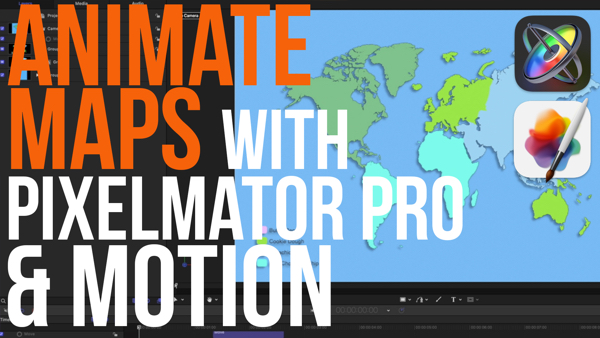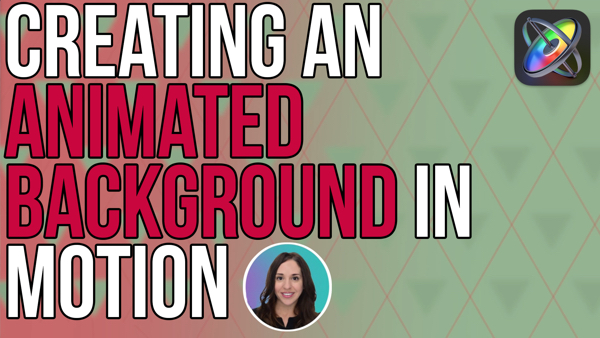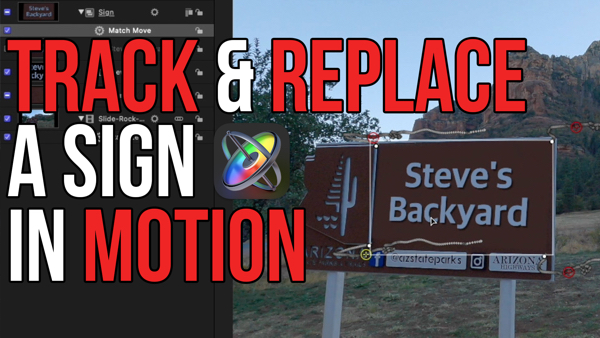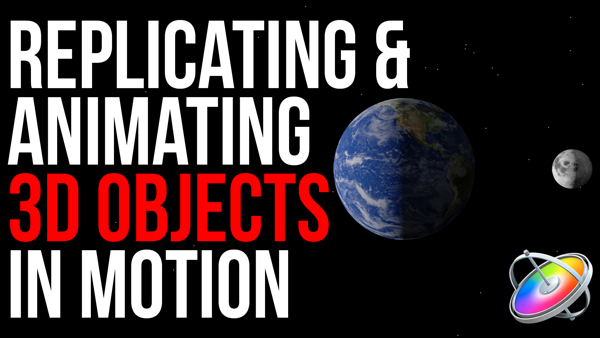How to Add Smoke to your Scene in Motion 5
In “Under 5 Minutes” Mark Spencer will teach you how to add smoke to a scene using the Smoke Particle Emitter.
To make it look more realistic, Mark will show you how to use the additive blend in cell controls, and then modify the Scale Over Life, Random Motion, and Gravity behaviors. For aesthetics, Mark adds a camera with a Dolly move to add some movement to the effect.
In this episode, I’ll show you how to add smoke to a scene.
I’m Mark Spencer from RippleTraining.com, welcome to Motion Magic where you’ll learn visual effects and motion graphics in under 5 minutes.
Here I am in Motion, where I have imported a photograph of cabin on a winter morning. I want to bring it to life with some smoke drifting from the chimney, and perhaps a subtle camera move.
In the Library, I’ll select Particle Emitters, then the Smoke folder.
Many of these presets could serve as good starting points. I’m going to select Black Smoke, then click Apply to add it to the top of the group in the Layers list.
Now I’ll select the emitter, and play some of the project.
We get a big plume of dark smoke. Not quite what I’m going for. I’ll stop the playhead in the middle of the project.
First, I’ll drag the emitter over the chimney. Then I’ll zoom in close by holding down Command-Spacebar and dragging right.
If this doesn’t work for you, you’ll need to first disable the default Spotlight shortcut in Preferences, and I’ll
position the start of the smoke over top of the chimney.
Then, I’ll select the Bezier mask tool and draw a mask to hide the bottom bit of smoke.
In the Heads Up Display, I’ll invert the mask, press Shift-Z to fit the entire image back to the Canvas, and click below all the layers to deselect the mask.
Now let’s make this smoke look a little more inviting. I’ll reselect the Emitter and head over to the Emitter Inspector.
In the Cell Controls, I’ll enable the Additive Blend checkbox, which adds the pixel color values of overlapping cells together, making them brighter.
That’s much too bright however, so I’ll open the gradient editor and I’ll right-click the white opacity tag, and make it a mid-gray color, which brings down the opacity of all the cells.
I’ll also change the color of the cells when they are born, making them brighter. And then, I’ll make them smaller by changing the Scale to about 23%.
Let’s play that back.
The smoke is moving a little too fast for my taste, so I’ll change the Speed to about 200.
In the Layers list, if I click the disclosure triangle for the cell of the emitter, we can see there are three behaviors animating the cells. I’ll select the Cell and go to the Behaviors Inspector so I can adjust them.
The first, Scale Over Life, make the cells change size over time. I’ll change the Scale at Birth to 100% to start them out smaller, and the Scale at Death to 700% so they don’t get quite so big.
The next behavior, Random Motion, makes the cells move in different directions from the ones assigned in the Emitter inspector. If I play now, I find the particles move too much to my liking, so I’ll reduce the Amount to 100. I’ll leave the rest of these parameters alone, but notice if I move the Drag amount to 0, how the particles shoot up unnaturally fast. I’ll undo that change.
The Gravity behavior is normally used to make object fall, but notice here that we have a negative value, which makes the smoke “fall” upwards – pretty tricky! Notice that if I set it to 0, how the particles barely move; they are now being overwhelmed by the Drag amount in the Random Motion behavior. So these behaviors interact with each other, and you can play with the parameters while the smoke is animating to find just the right look.
If I play now, the smoke looks good, but there is no smoke on the first frame. To fix that, I can select the Emitter, then in the mini-Timeline, move the playhead back home, and drag the Emitter bar back until I have a full column of smoke. Then I’ll move the playhead to the end of the project and press O to extend the emitter to the playhead.
This may take a moment because Motion needs to calculate the position of every particle over the entire project.
As final touch, I’ll add a camera to the scene by clicking the Camera button in the Toolbar. I’ll click Switch to 3D, then I’ll use the Behaviors shortcut menu to add the Dolly behavior to the camera.
With the playhead at the end of the project, I’ll increase the distance amount in the Heads-Up-Display to get the ending framing I want.
Click the subscribe button below. If you have an idea, comment or suggestion, leave those below as well. Go to Rippletrainging.com for fast professional training on Final Cut Pro, Motion and DaVinci Resolve from industry professionals.
I’m Mark Spencer from RippleTraining.com, welcome to Motion Magic where you’ll learn visual effects and motion graphics in under 5 minutes.
Here I am in Motion, where I have imported a photograph of cabin on a winter morning. I want to bring it to life with some smoke drifting from the chimney, and perhaps a subtle camera move.
In the Library, I’ll select Particle Emitters, then the Smoke folder.
Many of these presets could serve as good starting points. I’m going to select Black Smoke, then click Apply to add it to the top of the group in the Layers list.
Now I’ll select the emitter, and play some of the project.
We get a big plume of dark smoke. Not quite what I’m going for. I’ll stop the playhead in the middle of the project.
First, I’ll drag the emitter over the chimney. Then I’ll zoom in close by holding down Command-Spacebar and dragging right.
If this doesn’t work for you, you’ll need to first disable the default Spotlight shortcut in Preferences, and I’ll
position the start of the smoke over top of the chimney.
Then, I’ll select the Bezier mask tool and draw a mask to hide the bottom bit of smoke.
In the Heads Up Display, I’ll invert the mask, press Shift-Z to fit the entire image back to the Canvas, and click below all the layers to deselect the mask.
Now let’s make this smoke look a little more inviting. I’ll reselect the Emitter and head over to the Emitter Inspector.
In the Cell Controls, I’ll enable the Additive Blend checkbox, which adds the pixel color values of overlapping cells together, making them brighter.
That’s much too bright however, so I’ll open the gradient editor and I’ll right-click the white opacity tag, and make it a mid-gray color, which brings down the opacity of all the cells.
I’ll also change the color of the cells when they are born, making them brighter. And then, I’ll make them smaller by changing the Scale to about 23%.
Let’s play that back.
The smoke is moving a little too fast for my taste, so I’ll change the Speed to about 200.
In the Layers list, if I click the disclosure triangle for the cell of the emitter, we can see there are three behaviors animating the cells. I’ll select the Cell and go to the Behaviors Inspector so I can adjust them.
The first, Scale Over Life, make the cells change size over time. I’ll change the Scale at Birth to 100% to start them out smaller, and the Scale at Death to 700% so they don’t get quite so big.
The next behavior, Random Motion, makes the cells move in different directions from the ones assigned in the Emitter inspector. If I play now, I find the particles move too much to my liking, so I’ll reduce the Amount to 100. I’ll leave the rest of these parameters alone, but notice if I move the Drag amount to 0, how the particles shoot up unnaturally fast. I’ll undo that change.
The Gravity behavior is normally used to make object fall, but notice here that we have a negative value, which makes the smoke “fall” upwards – pretty tricky! Notice that if I set it to 0, how the particles barely move; they are now being overwhelmed by the Drag amount in the Random Motion behavior. So these behaviors interact with each other, and you can play with the parameters while the smoke is animating to find just the right look.
If I play now, the smoke looks good, but there is no smoke on the first frame. To fix that, I can select the Emitter, then in the mini-Timeline, move the playhead back home, and drag the Emitter bar back until I have a full column of smoke. Then I’ll move the playhead to the end of the project and press O to extend the emitter to the playhead.
This may take a moment because Motion needs to calculate the position of every particle over the entire project.
As final touch, I’ll add a camera to the scene by clicking the Camera button in the Toolbar. I’ll click Switch to 3D, then I’ll use the Behaviors shortcut menu to add the Dolly behavior to the camera.
With the playhead at the end of the project, I’ll increase the distance amount in the Heads-Up-Display to get the ending framing I want.
Click the subscribe button below. If you have an idea, comment or suggestion, leave those below as well. Go to Rippletrainging.com for fast professional training on Final Cut Pro, Motion and DaVinci Resolve from industry professionals.




